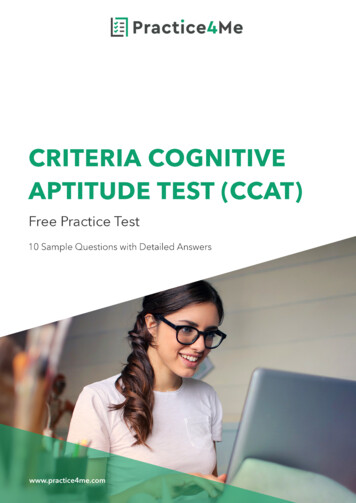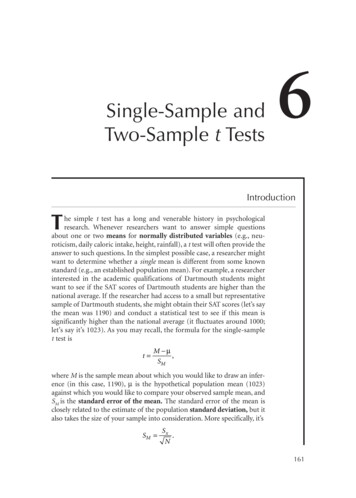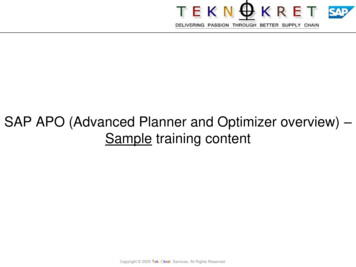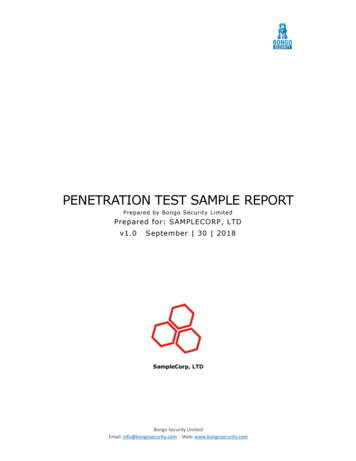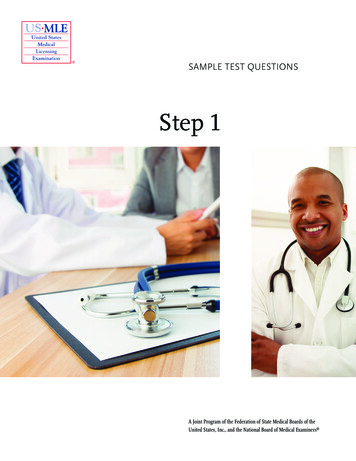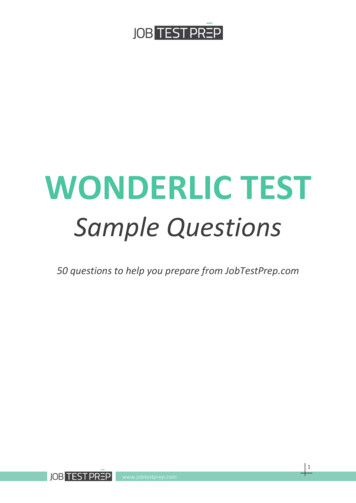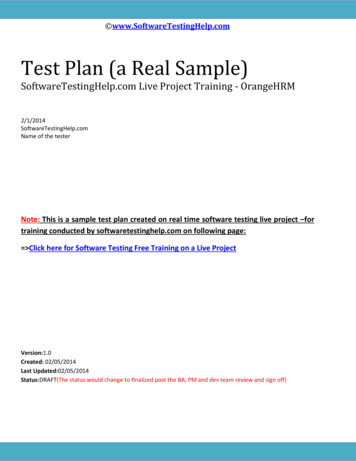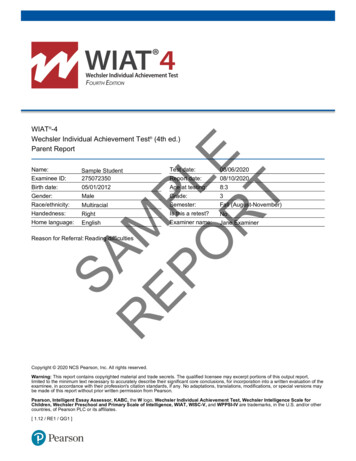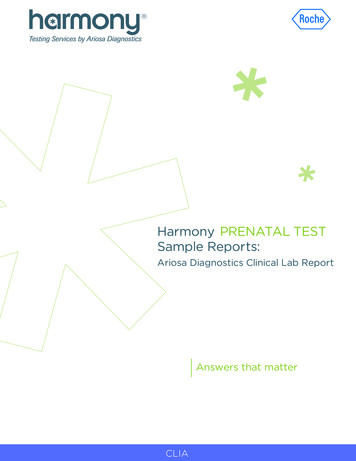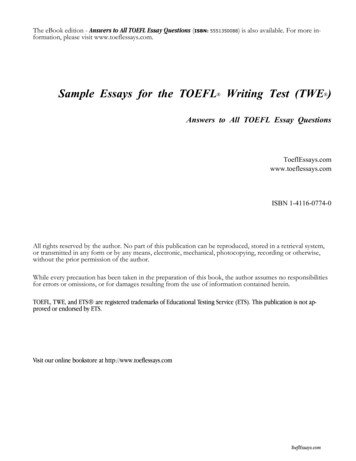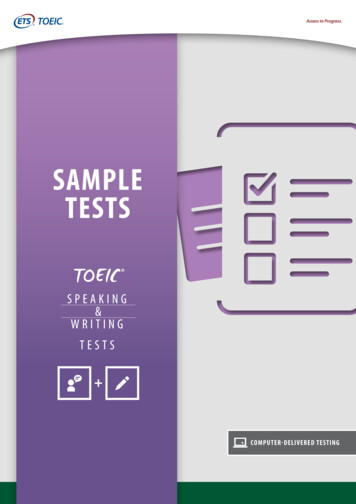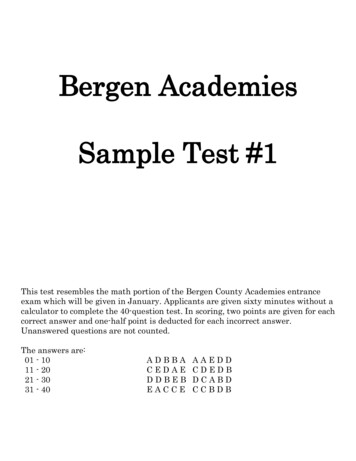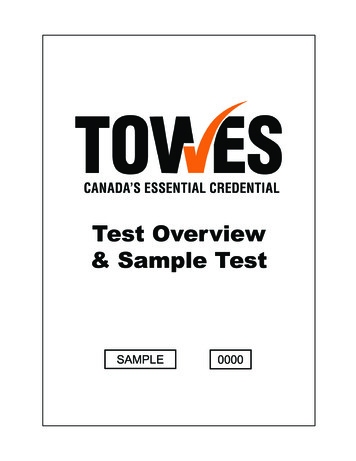
Transcription
Test Overview& Sample TestSAMPLE0000
TOWES is the sole property of Bow Valley Collegeand is sold through authorized distributors only.Copyright 2000 Bow Valley College. All rights reserved.Published 2009.For more informaƟon contact:Conrad Murphy,Director of TOWES & Career Advancement CentreBow Valley College,345 - 6 Avenue SE, Calgary, AB, T2G 4V1Phone: (403) 410-3200 Fax: (403) 297-4070orvisit: www.towes.caandwww.bowvalleycollege.caThe development of TOWES was funded by the NaƟonal Literacy Secretariat.
IntroductionThis sample booklet is intended to provideyou with an overview of a TOWES test. Itcontains detailed information on the research,design and applications of TOWES.Instead of using actual problem sets, wehave created this booklet to show you whata TOWES test looks like. The bookletillustrates features of TOWES design such asauthentic workplace documents and includesa commentary on how a test taker would goabout solving a particular item. In anactual test, problem sets are carefullyselected to reflect the requirements of aparticular occupation, or a group of relatedoccupations.Items actually used in a TOWES assessmenthave been rigorously tested in trials and haveestablished psychometric properties. Theitems in this book have not been subject tothese trials and do not have defined levels ofcomplexity.TOWES adheres to internationallyestablished psychometric guidelines toguarantee the quality of our assessment.All of the test items in our database remainhighly confidential to ensure fair andaccurate testing. The problem sets thatappear in this booklet have been retired fromactive use.This booklet is divided into three sections:Section 1TOWES Design and ApplicationPage 3The first section is a discussion of TOWES design, itsscope and utility in a variety of workplace assessmentsituations, and some of the features that make TOWESa unique assessment.Section 2Sample TOWES TestPage 9The Sample Test has the full introduction and practiceproblem set (Respirator Problem) used by testadministrators to show test-takers how to write the test.Following the introduction are ten problem sets that wefeel illustrate the important features of TOWES. Writethe sample test as though you were in a test situation.Section 3Answers and DiscussionPage 40The final section contains answers for the problem setsand a commentary on the design of selected test items.Test of Workplace Essential Skills1
kanBlgePa482Test of Workplace Essential SkillsTest of Workplace Essential Skills
The quick answer is that TOWES, as itsacronym suggests is a test of workplace essentialskills, but this description is only partly correct.Actually, TOWES is not a single test; it is a bankof test items which can be assembled intocountless test variations. Each test item is basedupon an authentic workplace task, ensuring thevalidity of the final assessment. TOWES problemsets are collections of test items that all use thesame workplace document and problem setup asthe stimulus. A typical test uses only twenty ofthese problem sets to reliably measure essentialskills. Given the number of problem sets availableand the number is growing constantly TOWESassessments can be purposefully constructed tomeet a wide variety of applications.Because TOWES is a custom-designed andapplication-specific workplace assessment, it alsorequires a tremendous amount of expertise todesign, develop and administer. This is the'service' side of TOWES. We hate to use wordslike 'system' and 'process,' but without a plan, wecould never deliver the results you need. Behindthe visible paper product, we have a team oftalented individuals, skilled in occupationalanalysis, test design, psychometrics, and testadministration. These consultants will help you todefine your assessment requirements, then analyzeworkplace skills and design TOWES to meet yourneeds. We will train test administrators andmarkers and assist you in developing testingprotocols and procedures. We also monitor testresults on a continuing basis to ensure test quality,reliability, and freedom from unwanted bias.TOWES is also available in 3 broadly basedgeneral series (G-Series) versions. Items in the GSeries booklets represent a range of occupationalsettings and results can be compared to nationalstandards established by HRSDC.Test of Workplace Essential Skills3
HRSDC’S Essential SkillsCanada. They are:Tested byTOWES{Reading TextDocument UseNumeracyWritingOral CommunicationComputer UseWorking with OthersHuman Resources and Social DevelopmentThinking Skills:Problem Solving Decision Making Job Task Planning and Organizing Finding Information Significant Use of MemoryContinuous Learning For more information about Essential Skills, visit the HRSDC Website at http://www.hrsdc.gc.ca/en/home.shtml4Test of Workplace Essential Skills
In order to move TOWES from betaversion to a finished product, the development team worked closely with StatisticsCanada to forge a link to IALS. This involved mixing test items from IALS with testitems from the TOWES item bank in a variety of configurations to produce fifteendifferent test variants. These tests were thencompleted by a national cross-section of theCanadian public aged 16 to 65 with a varietyof educational backgrounds. Test items fromthe International Adult Literacy Survey werewritten by thousands of residents of twentycountries, so linking TOWES to it has provided the development team with the statistical background required to fully interpretTOWES scores.How is TOWES designed?Custom test design means that the parameters for each TOWES assessment are defined by the requirements of the occupationor group of occupations under consideration.Occupational analysis reveals the context andscope of essential skills used at work. Thisinformation then guides item selection.While TOWES assesses transferable literacyand numeracy skills, the way that these skillsare ‘contextualized’ varies widely. Selectionof problem sets is based on three criteria. Thefirst is the cognitive domain which the itemis intended to measure; the second is the typeof task; and the third is complexity level.Items in a typical TOWES test are equallydivided among the three cognitive domainsbeing tested. The same number of test itemsare needed to establish a reliable score atwhatever complexity level is chosen.The complexity level of test items is determined by job or occupational requirements.Unlike norm-referenced tests which compareindividual scores to the scores of the rest ofthe test group, TOWES scores are referencedto the requirements of a particular job oroccupation.The type of task must also parallel theoccupation requirements. For instance,occupational analysis may reveal that anoccupation requires numeracy skills at anIALS level three for competent performance.It would also be important to know what typeof tasks were typical of the occupation. Sheetmetal workers perform complex measurement and calculation tasks, while a worker ina manufacturing plant may need equallysophisticated data analysis skills.Similarly, if the information used in anoccupation is displayed in columns and rows,maps or schematics, document tasks in theTOWES will use the same informationdisplay formats or types of documents. Bykeeping these criteria in mind, test items arechosen for content that is appropriate to theworkplace and difficulty levels that willallow the greatest generalization of testresults to the skills being measured.Why was TOWES developed?TOWES was developed in response to theneed for a more valid and appropriate test ofessential skills in the workplace. There arealternate tests of adult literacy and numeracy,but all were developed for other audiences orother contexts. TOWES allows workplacetrainers and educators to give employersuseful information about how the skills of theworkforce fit with job requirements. Themethodology and complexity scales developed for the Essential Skills Research Projectallow the skill requirements of jobs to bedescribed and rated in a uniform way.TOWES provides complementary information about the skills which the workforcebring to the job, and highlights the ‘fit’Test of Workplace Essential Skills5Test of Workplace Essential Skills - Sample Booklet5
Who developed TOWES?In 1998, SkillPlan and Bow Valley Collegeformed a joint venture to develop anassessment of the literacy and numeracy skillsrequired by workers. In 2004, Bow ValleyCollege became the sole owner of TOWES.Bow Valley CollegeHRSDC’s Essential SkillsTOWES is a good predictor of success intraining and can pinpoint skill gaps. In theworkplace, TOWES scores have beencorrelated to safety and accident rates. Thetest can be used in a variety of HR functionsincluding recruitment, training, needsassessment, succession planning and entranceinto apprenticeship.Bow Valley College is an innovative, worldclass college, rooted in communities, enablingpeople to learn a better living. Where peoplelive and work, Bow Valley College contributesto the vitality of communities and the strengthof the economy through innovative adulteducation programs and services which equippeople for successful living, lifelong learningand work in a global, knowledge-basedeconomy.Bow Valley College is known as anoutcomes-focused, innovative learning collegefor fast, focused, flexible quality learningservices for the workplace and in theworkplace anytime, anyplace. The college’smandate is to provide programs of instruction,training, and services to assist adult learnersin acquiring and maintaining foundations ofessential skills through the development oftheir communication skills, living skills, andproduction skills including: academicupgrading programs, career entry programs,and English as a Second Language programs.Bow Valley College offers credit and noncredit learning on a full and part-time basis,on campus, in the community, in theworkplace, and through distributed learning.Learning and services are delivered locally,provincially, nationally and internationally toindividuals and av/top nav/program/nls.shtmlwww.towes.com6Test of Workplace Essential Skills
COMPLEXITY LEVELSLevelsLevel 1(0-225)Level 2(226-275)Level 3(276-325)Level 4(326-375)Level 5(376-500)ReadingMost of the tasks in this level require therespondent to read relatively short text tolocate a single piece of informationwhich is identical to or synonymous withthe information given in the question ordirective. If plausible but incorrectinformation is present in the text, it tendsnot to be located near the correctinformation.Some tasks in this level requirerespondents to locate a single piece ofinformation in the text; however, severaldistracters or plausible but incorrectpieces of information may be present, orlow-level inferences may be required.Other tasks require the respondent tointegrate two or more pieces ofinformation or to compare and contrasteasily identifiable information based ona criterion provided in the question ordirective.Tasks in this level tend to requirerespondents to make literal orsynonymous matches between the textand information given in the task, or tomake matches that require low-levelinferences. Other tasks ask respondentsto integrate information from dense orlengthy text that contains noorganizational aids such as headings.Respondents may also be asked togenerate a response based oninformation that can be easily identifiedin the text. Distracting information ispresent, but is not located near thecorrect information.These tasks require respondents toperform multiple-feature matches and tointegrate or synthesize information fromcomplex or lengthy passages. Morecomplex inferences are needed toperform successfully. Conditionalinformation is frequently present in tasksat this level and must be taken intoconsideration by the respondent.Document UseTasks in this level tend to require therespondent either to locate a piece ofinformation based on a literal match or to enterinformation from personal knowledge onto adocument. Little, if any, distracting information ispresent.Some tasks in this level require therespondent to search for information indense text which contains a number ofplausible distracters. Others askrespondents to make high-levelinferences or use specialized backgroundknowledge. Some tasks ask respondentsto contrast complex information.Tasks in this level require the respondent to searchthrough complex displays that contain multipledistracters, to make high-level text-based inferences,and to use specializedknowledge.Tasks in this level are more varied than those inLevel 1. Some require the respondents to match asingle piece of information; however, severaldistracters may be present, or the match may requirelow-level inferences. Tasks in this level may also askthe respondent to cycle through information in adocument or to integrate information from variousparts of a document.NumeracyTasks in this level require the respondent toshow an understanding of basic numericalideas by completing simple tasks in concrete,familiar contexts where the mathematicalcontent is explicit with little text. Tasksconsist of simple, one-step operations suchas counting, sorting dates, performing simplearithmetic operations or understandingcommon and simple percents such as 50%*.Tasks in this level are fairly simple and relateto identifying and understanding basicmathematical concepts embedded in a rangeof familiar contexts where the mathematicalcontent is quite explicit and visual with fewdistracters. Tasks tend to include one-stepor two-step processes and estimationsinvolving whole numbers, benchmarkpercents and fractions, interpreting simplegraphical or spatial representations, andperforming simple measurements.Some tasks in this level require therespondent to integrate multiple pieces ofinformation from one or more documents. Others askrespondents to cycle through rather complex tablesor graphs which contain information that isirrelevan
The Sample Test has the full introduction and practice problem set (Respirator Problem) used by test administrators to show test-takers how to write the test. Following the introduction are ten problem sets that we feel illustrate the important features of TOWES. Write the sample test as though you were in a test situation. Section 3 Answers and Discussion Page 40 The final section contains .
